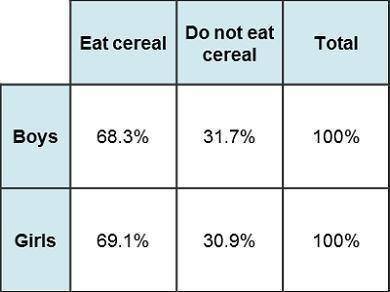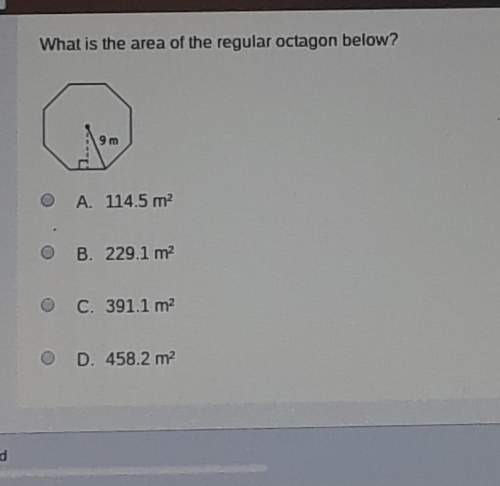
Mathematics, 30.11.2021 04:10 superstarsara5ouh83x
Relative Frequency Table by Rows
A 4-column table with 2 rows. Column 1 has entries boys, girls. Column 2 is labeled Eat cereal with entries 68.3 percent, 69.1 percent. Column 3 is labeled Do not eat cereal with entries 31.7 percent, 30.9 percent. Column 4 is labeled total with entries 100 percent, 100 percent.
What conclusion can you draw about the relative frequency of these results?
If you are a boy in this group, you are more likely not to eat cereal for breakfast than to eat cereal.
If you are a girl in this group, you are more likely to eat cereal for breakfast than not.
If you eat cereal for breakfast, you are a boy.
Knowing if a person eats cereal will help determine gender.


Answers: 2


Another question on Mathematics

Mathematics, 21.06.2019 17:00
Let f(x)=2x and g(x)=2x. graph the functions on the same coordinate plane. what are the solutions to the equation f(x)=g(x) ?me asap
Answers: 2

Mathematics, 21.06.2019 18:30
According to the 2008 u.s. census, california had a population of approximately 4 × 10^7 people and florida had a population of approximately 2 × 10^7 people. which of the following is true? a. the population of florida was approximately two times the population of california. b. the population of florida was approximately twenty times the population of california. c. the population of california was approximately twenty times the population of florida. d. the population of california was approximately two times the population of florida.
Answers: 1

Mathematics, 21.06.2019 19:30
The position of a moving particle is given by the position function: f(t)=-9t-t^2-0.2t^3+0.1t^4 a. at what time does the particle reverse direction? b. when is the displacement positive? (round one decimal place and answer in interval notation) c. when is the displacement negative? (round one decimal place and answer in interval notation) d. when is the particle’s acceleration positive? (round one decimal place and answer in interval notation) e. when is the particle’s acceleration negative? (round one decimal place and answer in interval notation)
Answers: 3

Mathematics, 21.06.2019 22:10
Atype of plant is introduced into an ecosystem and quickly begins to take over. a scientist counts the number of plants after mmonths and develops the equation p(m)= 19.3(1.089)^m to model the situation. most recently, the scientist counted 138 plants.assuming there are no limiting factors to the growth of the plants, about how many months have passed since the plants werefirst introduced? a)o 6.1b)0.6.6c)10 72d)o 23.1
Answers: 3
You know the right answer?
Relative Frequency Table by Rows
A 4-column table with 2 rows. Column 1 has entries boys, girls. C...
Questions

Mathematics, 13.01.2021 05:20


Advanced Placement (AP), 13.01.2021 05:20

Mathematics, 13.01.2021 05:20


Chemistry, 13.01.2021 05:20

History, 13.01.2021 05:20

Mathematics, 13.01.2021 05:20




Mathematics, 13.01.2021 05:20




Mathematics, 13.01.2021 05:20


Mathematics, 13.01.2021 05:20

English, 13.01.2021 05:20

History, 13.01.2021 05:20




